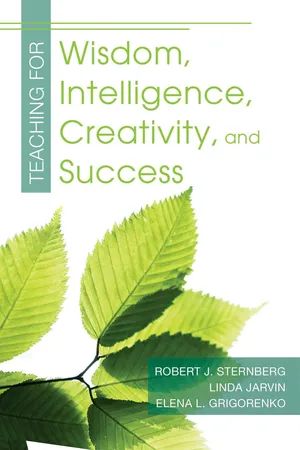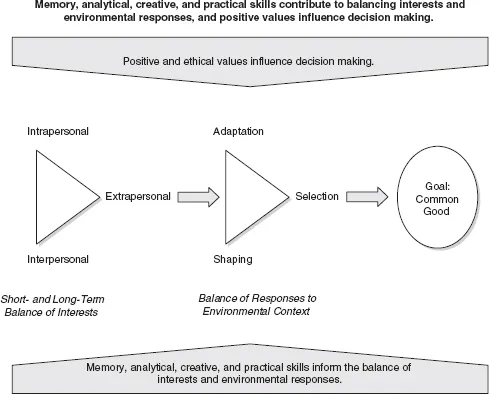![]()
PART I
Teaching for Wisdom, Intelligence, Creativity, and Success
![]()
1
Introduction to Teaching for Wisdom, Intelligence, Creativity, and Success
Part I briefly summarizes the theoretical model of human thinking and reasoning that we believe can provide insight into how students learn best. The theoretical model we refer to is known as “WICS” for Wisdom, Intelligence, and Creativity, Synthesized. We believe that wisdom, intelligence, and creativity are key ingredients in a successful person’s life, and that it is very important in educational settings to help students build on all these skills, in other words, to synthesize them. If you want to learn more about the theory behind the model, we have included an annotated bibliography of articles and books that describe the model more in detail in the Appendix to Part I at the end of this book. There, you will also find references to other authors who have investigated how students learn and offer strategies for teaching different skills such as analysis and creativity in the classroom.
Here we will just briefly review the WICS model, present some arguments for the importance of teaching for intelligence, creativity, and wisdom in the K–12 classroom, and finally, provide a brief self-evaluation scale for you, the reader, to determine your own profile of skills: Are your main strengths in memory, analytical, practical, or creative abilities, or in some combination of them? A scoring key is provided in Answer Key toward the end of the book.
Figure 1.1 gives a visual overview of the WICS model.
Figure 1.1 The WICS Model of Thinking
![]()
2
What Is the WICS Model?
The purpose of this book is to serve as a hands-on guide to inspire you to broaden your teaching and assessment repertoire to ensure that all students in your classroom are as successful as they can be. The goal is not to offer you an Introductory Psychology or Intelligence 101 course, but to provide you with suggestions for dealing with some practical and real situations in the classroom.
Before we start, however, we quickly summarize the different theories of intelligence that are in vogue and describe the one we subscribe to, so that you know our position and so that we’re all on the same page. In a nutshell, there are two kinds of theories of intelligence: (1) the singlefaceted, unified general intelligence (or g-factor) theories, which emphasize the nature of intelligence as a single entity; and (2) the multifaceted conceptions of intelligence, which emphasize the importance of multiple and distinctive aspects of intelligence.
Those who think that the first type of theory is correct generally view intelligence as relatively fixed and predetermined by genetic endowment, and as relatively independent from schooling. In other words, according to this theory, you are born with a certain amount of smarts, and the type of schooling you receive won’t change it that much. The authors of this book, however, subscribe to the second of these two conceptions of intelligence. Many researchers who are familiar to teachers subscribe to this view, for example, Howard Gardner, the author of the theory of Multiple Intelligences. Investigators in the second group generally agree that intelligence is the flexible capacity to learn from experience and to adapt to one’s environment (using the skills required by and acquired through a specific cultural and social context). They also tend to agree that intelligence can be developed, whether through formal explicit instruction or in informal educational situations (depending on the types of abilities considered). The authors of this book believe that everyone has some initial abilities, and that these can be developed into competencies, and that these competencies can in turn be honed into expertise. We believe that these initial abilities depend in part on genetic heritage, but the manner and degree to which this genetic endowment is realized depends on the individual’s environment. We believe that the key to success in the classroom—and in life more broadly—lies in a combination of intelligence, creativity, and wisdom, as per the WICS model.
We also believe there is an urgent need to teach to all abilities, and to match the assessment of achievement to such broad teaching. The time has come to capitalize on the variety of human resources because students’ talents do not happen to correspond to the skills that schools traditionally have emphasized. Creative and practical abilities are certainly as important in life as are memory and analytical abilities, and they can be as important in school if a school chooses to emphasize these abilities. The next parts of this book will provide you with more details on how to teach and assess for a broader range of abilities, and give you a wealth of concrete examples from classrooms at different grade levels and in different content areas.
Let’s say that, so far, you agree with us that, in order to succeed in life, students need more than rote memorization and the ability to analyze. Let’s say, also, that you think teachers should promote a broader range of skills in their classrooms to help more students of different abilities and learning profiles to succeed. At the same time, you may be asking yourself whether it’s worth trying to implement all these changes and broaden your teaching repertoire. Teachers today are under a lot of pressure and have many constraints related to seeing their students perform well on tests. Indeed, many teachers we have worked with over the years say that although they would like to include more creative activities in their classroom, for example, their school administration is not supportive and emphasizes only the importance of test scores. We all want to promote high achievement in our students, and we think that by broadening your teaching repertoire and addressing the needs of a wider range of students with different learning styles, you will do exactly that. You will help students—all students—achieve at higher levels. Teaching for creativity is not just a nice and fun add-on to the regular curriculum. On the contrary, it is a means to teach content, the content that our local, state, and federal standards and scope and sequence guidelines ask us to teach. In the Appendix to Part I at the end of this book, you’ll find references to studies where we have actually measured whether or not this approach promotes learning (it does!), but for now, let’s just list the four main reasons why the WICS model works for students and teachers.
REASON #1: APPRECIATION OF DIFFERENCES
To teach within the WICS model is to create a supportive learning environment in which students find their own ability patterns, understand how uniqueness allows each individual to make a particular contribution to the learning community, and value diversity. One step toward thi...

